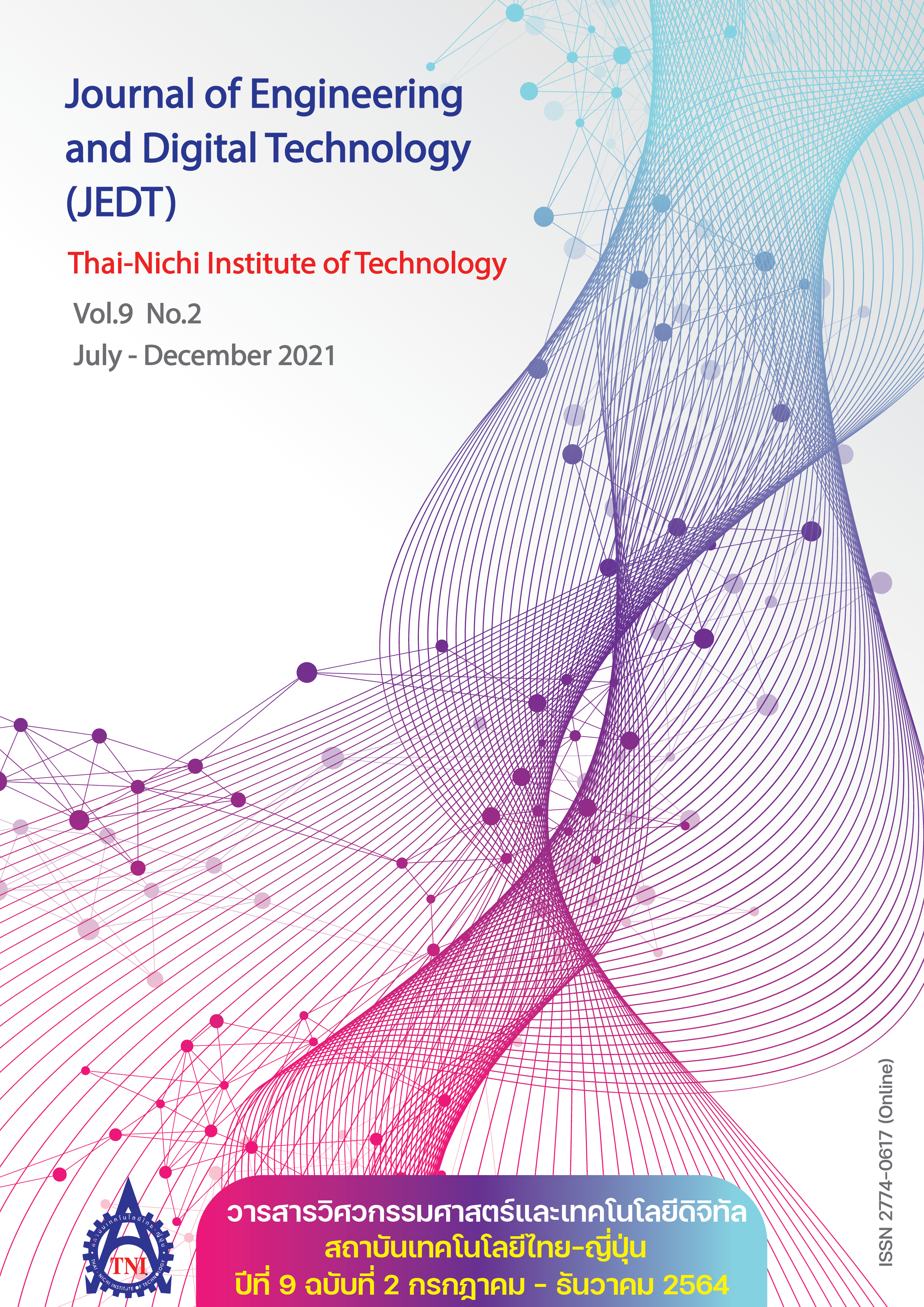Adaptive Pseudocoloring Method based on Color Image Scale for Emotional Art Image
Main Article Content
บทคัดย่อ
Color can dramatically affect and arouse the emotions. In this paper, we propose a pseudocoloring method by applying the color psychology of color image scale to create an emotional art image. The proposed technique utilizes two key color groups, image segmentation, shape-preserving piecewise cubic Hermite interpolation with uniform lightness difference, Gaussian filter and morphological gradient to develop an adaptive color mapping of grayscale image. The key color groups of the desired emotion are extracted from the color image scale and the color map is generated from the interpolation results in CIELAB color space for each key color group to the segmented area. The simulation results show that the smooth gradient of key colors impressively transfers an implicative emotion of the image. In addition, soft transition between key color groups by smoothing at the edge of segmented area makes the image more artistic appeal. The emotional art image of the proposed pseudocoloring method could enrich the digital decoration and color therapy in both artifactual and natural images.
Article Details

อนุญาตภายใต้เงื่อนไข Creative Commons Attribution-NonCommercial-NoDerivatives 4.0 International License.
นโยบายการรับบทความ
กองบรรณาธิการวารสารสถาบันเทคโนโลยีไทย-ญี่ปุ่น มีความยินดีรับบทความจากอาจารย์ประจำ และผู้ทรงคุณวุฒิในสาขาวิศวกรรมศาสตร์และเทคโนโลยี ที่เขียนเป็นภาษาไทยหรือภาษาอังกฤษ ซึ่งผลงานวิชาการที่ส่งมาขอตีพิมพ์ต้องไม่เคยเผยแพร่ในสิ่งพิมพ์อื่นใดมาก่อน และต้องไม่อยู่ในระหว่างการพิจารณาของวารสารอื่นที่นำส่ง ดังนั้นผู้สนใจที่จะร่วมเผยแพร่ผลงานและความรู้ที่ศึกษามาสามารถนำส่งบทความได้ที่กองบรรณาธิการเพื่อเสนอต่อคณะกรรมการกลั่นกรองบทความพิจารณาจัดพิมพ์ในวารสารต่อไป ทั้งนี้บทความที่สามารถเผยแพร่ได้ประกอบด้วยบทความวิจัย ผู้สนใจสามารถศึกษาและจัดเตรียมบทความจากคำแนะนำสำหรับผู้เขียนบทความ
การละเมิดลิขสิทธิ์ถือเป็นความรับผิดชอบของผู้ส่งบทความโดยตรง บทความที่ได้รับการตีพิมพ์ต้องผ่านการพิจารณากลั่นกรองคุณภาพจากผู้ทรงคุณวุฒิและได้รับความเห็นชอบจากกองบรรณาธิการ
ข้อความที่ปรากฏภายในบทความของแต่ละบทความที่ตีพิมพ์ในวารสารวิชาการเล่มนี้ เป็น ความคิดเห็นส่วนตัวของผู้เขียนแต่ละท่าน ไม่เกี่ยวข้องกับสถาบันเทคโนโลยีไทย-ญี่ปุ่น และคณาจารย์ท่านอื่น ๆ ในสถาบัน แต่อย่างใด ความรับผิดชอบด้านเนื้อหาและการตรวจร่างบทความแต่ละบทความเป็นของผู้เขียนแต่ละท่าน หากมีความผิดพลาดใด ๆ ผู้เขียนแต่ละท่านจะต้องรับผิดชอบบทความของตนเองแต่ผู้เดียว
กองบรรณาธิการขอสงวนสิทธิ์มิให้นำเนื้อหา ทัศนะ หรือข้อคิดเห็นใด ๆ ของบทความในวารสารสถาบันเทคโนโลยีไทย-ญี่ปุ่น ไปเผยแพร่ก่อนได้รับอนุญาตจากผู้นิพนธ์ อย่างเป็นลายลักษณ์อักษร ผลงานที่ได้รับการตีพิมพ์ถือเป็นลิขสิทธิ์ของวารสารสถาบันเทคโนโลยีไทย-ญี่ปุ่น
ผู้ประสงค์จะส่งบทความเพื่อตีพิมพ์ในวารสารวิชาการ สถาบันเทคโนโลยีไทย-ญี่ปุ่น สามารถส่ง Online ที่ https://www.tci-thaijo.org/index.php/TNIJournal/ โปรดสมัครสมาชิก (Register) โดยกรอกรายละเอียดให้ครบถ้วนหากต้องการสอบถามข้อมูลเพิ่มเติมที่
- กองบรรณาธิการ วารสารสถาบันเทคโนโลยีไทย-ญี่ปุ่น
- ฝ่ายวิจัยและนวัตกรรม สถาบันเทคโนโลยีไทย-ญี่ปุ่น
เลขที่ 1771/1 สถาบันเทคโนโลยีไทย-ญี่ปุ่น ซอยพัฒนาการ 37-39 ถนนพัฒนาการ แขวงสวนหลวง เขตสวนหลวง กรุงเทพมหานคร 10250 ติดต่อกับคุณพิมพ์รต พิพัฒนกุล (02) 763-2752 , คุณจุฑามาศ ประสพสันติ์ (02) 763-2600 Ext. 2402 Fax. (02) 763-2754 หรือ E-mail: JEDT@tni.ac.th
เอกสารอ้างอิง
S. Sankaran, J. M. Maja, S. Buchanon, and R. Ehsani, “Huanglongbing (citrus greening) detection using visible, near infrared and thermal imaging techniques,” Sensors, vol. 13, no. 2, pp. 2117–2130, Feb. 2013, doi: 10.3390/s130202117.
H. Li, C. Chen, S. Fang, and S. Zhao, “Brain MR image segmentation using NAMS in pseudo-color,” Comput. Assist. Surg., vol. 22, no. sup1, pp. 170–175, Oct. 2017, doi: 10.1080/24699322.2017.1389395.
H. Jiang, Y. Zhao, J. Gao, and Z. Gao, “Adaptive pseudo-color enhancement method of weld radiographic images based on HSI color space and self-transformation of pixels,” Rev. Sci. Instrum., vol. 88, no. 6, Jun. 2017, doi: 10.1063/1.4985007.
J. J. McCann and V. Vonikakis, “Calculating retinal contrast from scene content: A program,” Front. Psychol., vol. 8, Jan. 2018, Art. no. 2079, doi: 10.3389/fpsyg.2017.02079.
R. Doi, “Maximizing the accuracy of continuous quantification measures using discrete packtest products with deep learning and pseudocolor imaging,” J. Anal. Methods Chem., vol. 2019, Apr. 2019, Art. no. 1685382, doi: 10.1155/2019/1685382.
Y. Zheng, “X-ray image processing and visualization for remote assistance of airport luggage screeners,” M.S. thesis, Dept. Elec. Eng., Univ. Tennessee, Knoxville, USA, 2004.
L. Jinxiu, L. Junli, and W. Ping, “Pseudocolor coding of medical images based on gradient,” in Proc. 1st Int. Conf. Bioinform. Biomed. Eng., Jul. 2007, pp. 932–935, doi: 10.1109/ICBBE.2007.242.
R. Jayadevan, K. N. Latha, and K. A. Navas, “Automated pseudo-coloring of grayscale images based on contourlet transform,” in Proc. IEEE Nat. Conf. Commun. Signal Process. Netw., Palakkad, India, Oct. 10-12, 2014, pp. 1–6, doi: 10.1109/NCCSN.2014.7001146.
M. Zare, K. B. Lari, M. Jampour, and P. Shamsinejad, “Multi-GANs and its application for pseudo-coloring,” in Proc. 4th Int. Conf. Pattern Recognit. Image Anal. IPRIA 2019., Tehran, Iran, Mar. 6–7, 2019, pp. 1–6, doi: 10.1109/PRIA.2019.8786027.
R. Jayadevan, K. N. Latha, K. A. Navas, and A. Ananthan, “A review on recent pseudo-coloring techniques,” Int. J. Sci. Technol. Eng., vol. 1, no. 11, pp. 344–348, May 2015.
S. Moharreri, N. J. Dabanloo, and K. Maghooli, “Detection of emotions induced by colors in compare of two nonlinear mapping of heart rate variability signal: Triangle and parabolic phase space (TPSM, PPSM),” J. Med. Biol. Eng., vol. 39, pp. 665–681, Jan. 2019, doi: 10.1007/s40846-018-0458-y.
H. Nagumo, New Color Image Chart. Tokyo, Japan: Graphic-sha, 2016.
N. Otsu, “A threshold selection method from gray-level histograms,” IEEE Trans. Syst. Man Cybern., vol. 9, no. 1, pp. 62–66, Jan. 1979.
F. N. Fritsch and R. E. Carlson, “Monotone piecewise cubic interpolation,” SIAM J. Numer. Anal., vol. 17, no. 2, pp. 238–246, 1980.


